Do-it-yourself heat gun: manufacturing options for different types of fuel
With the help of heat guns, you can quickly increase the air temperature even in large rooms, which is why they are so successfully used for heating farms, greenhouses, warehouses and other industrial buildings.
But if you are looking for an inexpensive device for private use: heating a garage, heating equipment, or drying finishing materials, a homemade solution made from readily available components may be the solution. We will look at how to properly assemble a heat gun with your own hands in this article, offering you three simple options.
But first, let's look at the main types of these devices and their features. We will also pay attention to the rules of safe operation.
The content of the article:
Types of heat guns and their features
The operating principle of all guns is almost the same - they draw in cold air, heat it and disperse it throughout the room in a warm stream. The main structural elements of heat generators are: housing, motor, fan (except for IR devices) and heating element.
The main difference between devices, which determines their power and productivity, is the energy source.
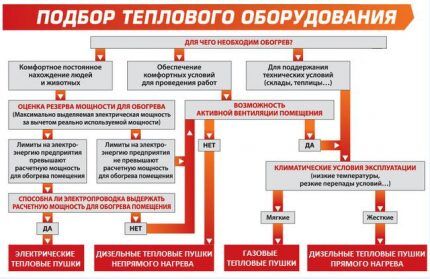
Let's consider the existing types of heat guns and the nuances of their operation.
Type No. 1 - liquid fuel units
The most powerful guns, widely used for industrial, construction and agricultural needs, operate on liquid fuel (diesel, diesel fuel, gasoline, kerosene and even oil recovery). The fuel ignites directly in the gun chamber and heats the air pumped by the compressor to high temperatures.
Thanks to the non-freezing fuel, such units are effective even outdoors at temperatures of -30 degrees and below.

By type of heating they are divided into:
- Direct flow - the most powerful devices among all types of heat guns, which impress with their productivity. Their efficiency confidently reaches 100%, maximum power is 220 kW, and the outlet air temperature is up to 400 degrees. But, despite such high efficiency, the use of such guns is limited to non-residential buildings where there are no people or other living creatures, and open construction sites. And all because with direct heating, substances harmful to health remain in the hot air stream.
- Aggregates indirect heating – have a closed combustion chamber equipped with an exhaust chimney, so they can be used in crowded rooms.And although the efficiency of such devices will be significantly lower than that of direct-flow devices (about 60%), due to minimal power consumption and low fuel cost, they are popular both on an industrial scale and for private use.
Depending on the availability and quality of filters, as well as other design nuances, there are diesel or multi-fuel guns.
The former prefer “winter” diesel fuel, kerosene and diesel fuel, the latter are perfectly accepting of cheaper types of fuel, including waste oil, and therefore are especially in demand for heating car repair shops, gas stations and other premises where this fuel is in abundance.
We have given an overview of the best manufacturers of direct and indirect heating guns In this article.
Type No. 2 - gas heat generators
Gas heat guns can act as stationary heaters and be connected to the main pipeline with natural gas. But you can also use them as mobile structures, if you stock up on a cylinder with liquefied propane/butane, which it is advisable to equip gearbox for safe operation.
Like liquid fuels, gas guns are divided into direct and indirect heating devices.
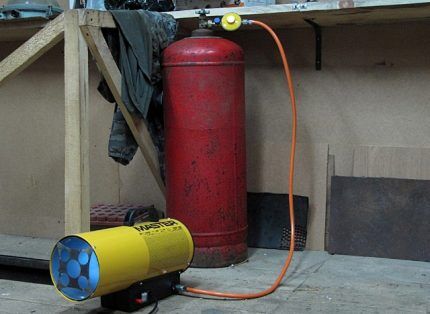
Operating principle of the gas unit:
- The gas flow enters the burner in the chamber.
- Ignition ignites the fuel and heats the heat exchanger to a high temperature.
- The fan circulates flows of cold and hot air.
- Gas combustion products either remain in the flow (during direct heating) or are discharged into the chimney.
The disadvantages of the device include loud operation (the noise of the fan is also accompanied by loud pops when connected to the cylinder) and the need for regular ventilation of the room.
The power of gas heat generators reaches 140 kW, which is much higher than electrical appliances, but inferior to diesel units. The main advantages are fast heating of the room and low fuel cost.
Type No. 3 - electric heat guns
Inside the metal body of the device there is an open spiral or heating element, converting electric current into thermal energy. Thanks to the operation of the fan, the air circulates along the heating element, increases its temperature and leaves the “barrel” of the gun already warm.
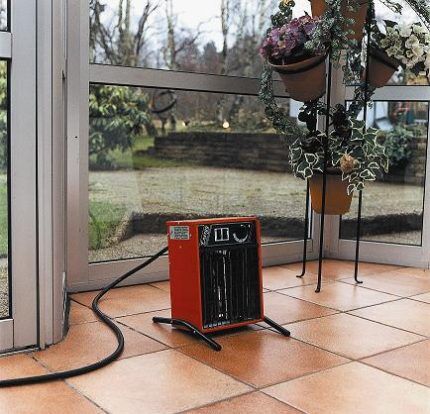
Advantages of electric heaters:
- No harmful fumes - the device is environmentally friendly and does not pollute the air from waste fuel.
- Availability of energy source - for low-power devices, a conventional power supply of 220 W is sufficient, but devices with characteristics of 5 kW or more will require connection to a three-phase network.
- Low price - electrical appliances belong to the most budget segment of heat guns.
- Ability to work at low temperatures.
- No need to refuel.
In addition to being “tied” to electricity, one of the disadvantages is the low power of the device (from 1 to 45 kW) - for open areas or poorly insulated buildings they are ineffective.Also, heating elements dry out the air greatly, so the room will have to be ventilated regularly. Well, the main disadvantage of any electrical equipment is the impressive bills for paying for electricity.
Type No. 4 - water and infrared devices
And let’s finish our review of the range with two types of heat generators, which have significant structural differences from other guns.
In infrared devices, thermal energy is converted into a flow of infrared radiation, which heats the air a second time, because the bulk of the heat goes to the objects at which the “barrel” is directed. Therefore, such heaters are widely used in severe frosts to start equipment, as well as on construction sites - for drying materials, screeds, plaster, paint and varnish products. The device itself runs on DP or diesel fuel.

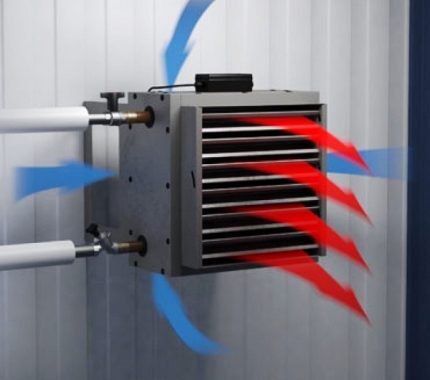
The design of the water gun is complemented by a heat exchanger with hot water. In fact, these are familiar air heaters or an additional battery with a fan, which is connected to the central heating system.
The essence of the device’s operation is simple - circulating hot water transfers its heat to the heat exchanger pipes, which heat the air, and the fan distributes it throughout the entire volume of the room.
Options for making your own heat guns
If it is better to purchase a water and infrared unit ready-made, then it is quite easy to make an electric, diesel and even gas heater with your own hands.
Let's take a closer look at the sequence of work on manufacturing simple low-power guns.
Homemade #1 - DIY gas gun
To heat a garage, country house or small greenhouse, you can make a heating unit that will be connected to a gas cylinder. But for this you will need a grinder, a drill with metal drills and a welding machine.
Have you ever done welding? In this case, we recommend educational program electric welding for beginners.
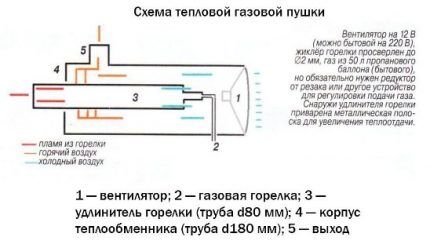
To assemble the structure you will need the following elements:
- a thick-walled fire-resistant pipe, which will act as a body, 1-1.5 m long and up to 18 cm in diameter;
- a second metal pipe with a smaller diameter is for the combustion chamber;
- metal plates-strips 2 mm thick – 4-8 pcs;
- burner (can be from a gas boiler or water heater);
- hose with a reducer for adjusting the gas supply;
- a fan whose size matches the internal diameter of the future case;
- fittings for the legs or pallet on which the gun will be placed.
Step-by-step manufacturing instructions:
- You need to drill holes in the pipe on both sides at a distance of 2-3 cm from the edge. The first is designed to supply gas, so its diameter must match the size of the hose. The second is for the outlet pipe with hot air, about 5 cm in diameter.
- A narrower pipe is inserted inside the body - the future combustion chamber.Metal plates need to be welded to it, which will securely fix the structure, and this “core” is installed so that its edge protrudes beyond the boundaries of the large pipe.
- From sheet metal cut with a grinder, and then a circle is welded of such a size as to hermetically close the end gap formed between the inner and outer pipe.
- Now a burner is installed in the combustion chamber (some craftsmen replace this with a metal shower head, but it is better to use a factory part). Then a hole for ignition is drilled and attached gas supply hose.
- The housing opening is closed on the second side with a fan, which is fixed with self-tapping screws onto a metal flange and welded to the pipe.
- To install the device correctly, it is important to consider a stable base, for example, make a frame structure from iron reinforcement.
After assembling the heat gun, you need to check the quality of the seams and the tightness of all connections (especially the gas hose). Only after this can you do a test run: light the burner through the ignition hole, open the fuel supply valve, make sure that the gas starts to burn and turn on the fan.

Additionally, you can equip the gun with a thermostat so that it stops when the room temperature reaches the programmed value (and, accordingly, turns on when the degree drops).
A damper or rotating damper installed between the homemade metal and factory fan flanges will help control the power of the air flow.
Homemade product #2 - electric heater with heating element
A heat gun powered by electricity is the easiest device to manufacture. True, due to the high consumption of electricity, it is rarely used as the main heating, but this is a good option for reducing humidity and quickly warming up a room for an overnight stay in a country house or while working in a garage or workshop.

To make it you will need:
- A blank for the housing can be a sheet of galvanized metal 1 mm thick, an asbestos pipe, an old pan or other container with a diameter of up to 25 cm (it is better to use the dimensions of the fan and heating element as a guide).
- A heating element.
- An electric motor with an impeller - depending on the size and power of the gun, this can be either a fan from a household hood or an element from an old Soviet vacuum cleaner.
- A switch that opens and connects a circuit in a network.
- Pads for fixing the heater.
- Safety circuit breakers - for a 25 A spiral and for a 6 A motor.
First, we make a body with a diameter of 20-25 cm - if it is a sheet of iron, it needs to be bent into a cylinder shape, welded or fixed with rivets. A heating element is placed inside the “barrel” and secured at right angles to the walls of the housing.

Instead of ready-made heaters, you can also use nichrome thread wound on a frame made of a strip of asbestos sheet or other suitable material. This design will occupy a large area (almost the entire length of the pipe) and, accordingly, will heat the room faster.
The second edge of the gun is closed with an impeller and fixed to standard fasteners. After this, all that remains is to separately connect the heating element and the fan to the power cord through fuses and attach a switch that disconnects the power supply.
A mandatory point is that all wires and ends of the spiral outside the gun must be carefully insulated.

If a sheet of metal was used for the body, it is worth thinking about its additional thermal insulation and a stand made of the same reinforcement. And for convenient transportation, you need to equip the gun with 1-2 handles.
Don't want to bother making homemade stuff? In this case, it’s easier to buy a ready-made gun in a store - we recommend that you familiarize yourself with the best manufacturers such equipment.
Homemade #3 - diesel gun
To assemble a unit that runs on liquid fuel, you need to make three main structural elements - a housing, a combustion chamber and a fuel tank equipped with a pump. And for this you will need a welding machine and good experience working with it.
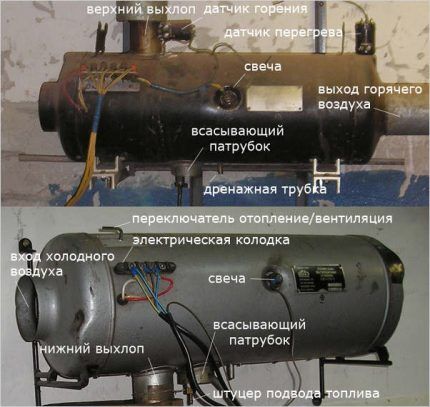
Algorithm for assembling a liquid fuel gun:
- For the body you need to select a cylindrical container or a galvanized pipe of large diameter. A combustion chamber is placed inside - a thick-walled pipe with a diameter half the size of the body, at the end of which a nozzle is attached. Also, the combustion chamber must be equipped with a spark-producing device, for example, a piezo ignition or a spark plug.
- After installing and centering the camera, the outer casing is sealed on one side and covered with a fan on the other. Only the technological holes for the smoke exhaust pipe and for the nozzle remain open.
- For fuel, you need to choose a container with a volume of 5-10 liters. You can buy a ready-made tank or make it yourself, the main requirement is that it be made of a material with low thermal conductivity, which prevents the structure from overheating. If this is not found, take a metal container and simply wrap it with thermal insulation.
- Then you need to place a high pressure pump and a cleaning filter between the upper housing and the lower fuel tank.
- Now we connect the nozzle with the pump and filter using a red copper annealed tube for supplying fuel, and equip the fan with a dimmer and connect it to the mains.
- At the final stage, it remains to weld a pipe with a pipe or corrugation to the body to remove combustion products.
Before you test run the device, be sure to show it to a professional - for example, a specialist from a car service center.
Rules for the safe use of guns
It is no secret that all home-made devices are objects of increased danger, because improper design and assembly can cause fire, electric shock and other troubles.
But most accidents occur not so much due to design errors, but rather due to simple neglect of safety measures.
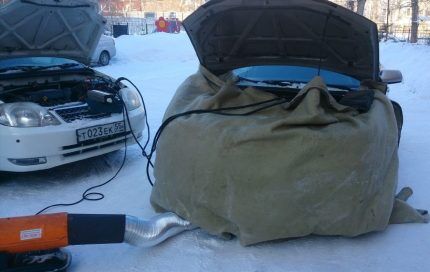
Let us recall the basic operating rules:
- All direct heating heat guns can only be used if there is good (preferably forced) ventilation. But even in such conditions, staying longer than a couple of hours in a room with a direct-flow diesel or gas gun is fraught with headaches and other symptoms of poisoning.
- The body of the gun (especially if it is made of metal) gets very hot during operation, because, unlike factory models, homemade devices are not equipped with heat-insulating layers inside the casing. Therefore, it is important to take care of a stable base, which will prevent the cylinder from spontaneously rolling, and a handle that does not heat up.
- The “barrel” of units with open burners should be covered with a protective mesh screen, and it is advisable to equip the electric gun with grounding.
- Never direct hot air towards fuel cans or gas cylinders. And in general, the distance from the hot air outlet to the nearest object should be at least 2 meters.
- To ignite the burner in a gas and diesel gun, use a special lighter with a long handle.
- Before turning off, let the fan run without fuel for a few minutes so that it can cool the device.
And lastly, no matter how confident you are in the quality of the assembly and the safety of the connections, never leave your homemade gun to work unattended.
Conclusions and useful video on the topic
To get a clear idea of guns powered by various energy sources, we have prepared several videos with tips from craftsmen who have already assembled devices from all kinds of available materials. Perhaps one of the examples will inspire you to experiment.
Gas gun made for heating a garage:
How to make an electric gun from an old fire extinguisher:
Homemade heat generator operating on waste oil:
Electric gun from a regular saucepan:
Although it seems that a homemade cannon is the most budget-friendly solution to the problem of heating non-residential premises, its manufacture requires certain knowledge and experience.
The price of a mistake can be an explosion of equipment, fire, poisoning by combustion products, and even human life. Therefore, really evaluate your skills and think: perhaps you should enlist the support of specialists or just buy ready-made device.
Have you decided to assemble a heat gun from scrap materials and want to clarify a couple of nuances? Ask your questions to our experts and other site visitors in the block below this article.
Or maybe we already use a homemade gun and want to give some advice to newcomers in this matter? Share a unique photo of your creation, write recommendations, and leave valuable comments.




I want to try to make a small heat gun to heat the loggia during the cold season.Loggia with cold glazing and ventilation holes in the lower part (not closed). Sometimes I want to sit on the loggia in winter without putting on winter clothes. The area is approximately 6 squares. Experts, tell me what type of heat gun is best for this? I'm leaning towards electric, but there is no electricity outlet on the loggia yet, so I'll have to do it.
Vladimir, you are inclined correctly, especially if you only need to warm up the loggia from time to time. An electric heat gun is the most convenient and safe option for home use. I was making a cannon for the garage. I often go there for a long time in the winter (I work), so I chose a cannon from a gas cylinder, because... in my case, it would be easier to go broke with an electric one.